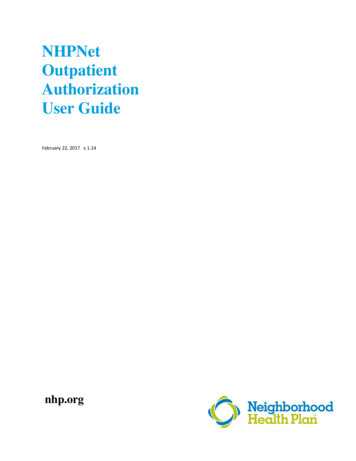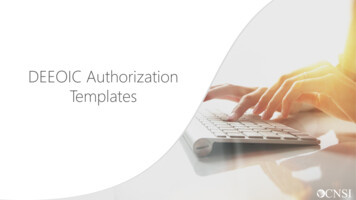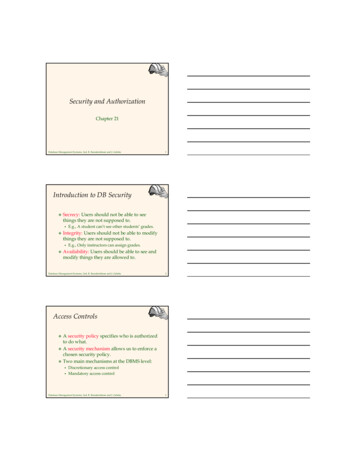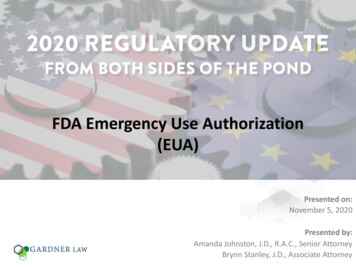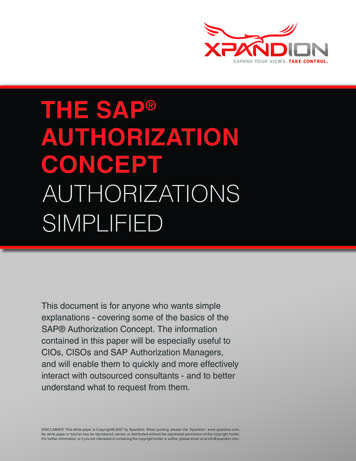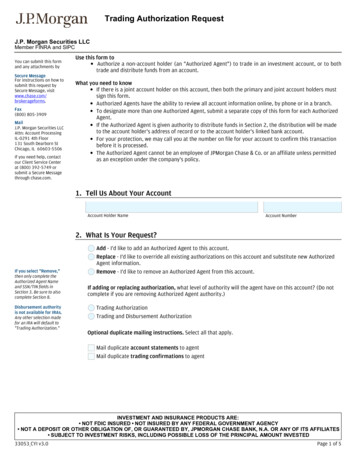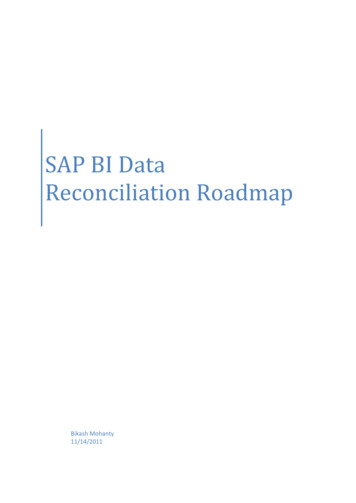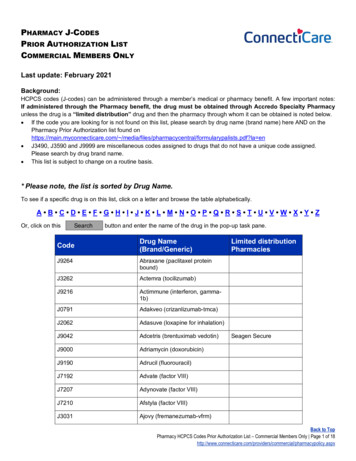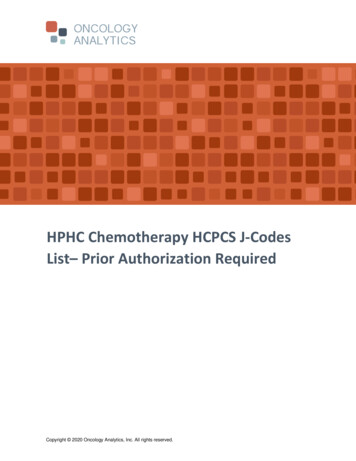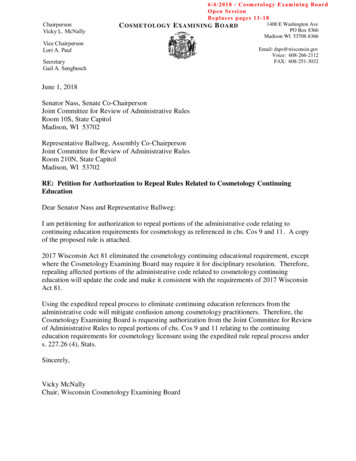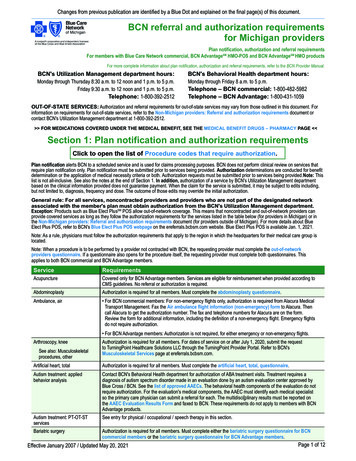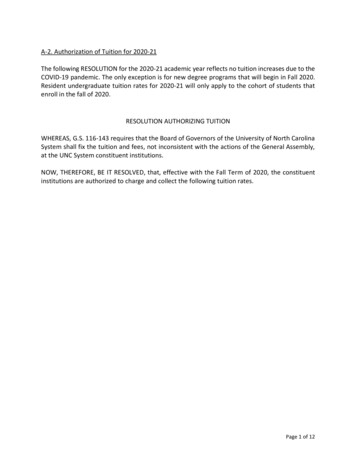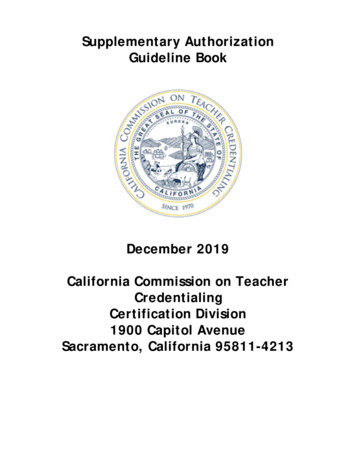
Transcription
Supplementary AuthorizationGuideline BookDecember 2019California Commission on TeacherCredentialingCertification Division1900 Capitol AvenueSacramento, California 95811-4213
Supplementary Authorization Guideline Bookpage 1The purpose of this Guideline book is to provide information regarding the requirementsto qualify for adding a supplementary authorization to a credentialI. IntroductionThe supplementary authorization has been in regulation since 1979. These regulationsenable the holder of a single subject credential to have one or more subject areas be addedas a supplementary authorization. In 1980 the Commission adopted Title 5 regulations toallow supplementary authorization be added to Multiple Subject Teaching Credentials. Theintent was to provide an alternate method of adding a new teaching authorization to allowan individual to teach a class in a subject outside the area in which he or she earned acredential.II. Supplementary AuthorizationsSupplementary authorizations allow the holder to add one or more subjects to his or herteaching credential. There are two types of supplementary authorizations; introductory andspecific. The introductory supplementary added to Single subject teaching credentialauthorizes the holder to teach at any grade level the supplementary subject matter contenttypically included in curriculum guidelines and textbooks for study in grades 9 and below.The introductory supplementary added to a Multiple subject teaching credential authorizesthe holder to teach departmentalized classes related to the supplementary in grades 9 andbelow. The specific supplementary added to the Single subject teaching credentialauthorizes the holder to teach the specific subject in grades preschool, kindergarten-12, andclasses organized primarily for adults.Documents Supplementary Authorizations May Be Added To: Single Subject CredentialsMultiple Subject CredentialsStandard Elementary and Secondary CredentialsUniversity Internship Credentials (Multiple and Single Subject only)Special Secondary Credentials in Academic Subject: Art, Business Education, Homemaking, Industrial Arts, Music, Physical Education, Speech Arts, andVocational AgricultureDocuments Supplementary Authorizations May Not Be Added To: General Kindergarten-Primary, Elementary, Junior High, or Secondary Credentials District Intern Credentials Special Secondary Credentials in Non-Academic Subject: Aviation, Blind, Deaf, Lip Reading, Nursing Education, Partially Sighted Child, Public Safety and AccidentPrevention Including Driver Education and Driver Training, Sciences Basic to Medicine, Correction ofSpeech Defects, and Mentally Retarded Special Education Credentials (current or previous) Adult or Vocational Credentials Career Technical Education Teaching Credentials
Supplementary Authorization Guideline Bookpage 2The holder of a Life Multiple or Single Subject, or Clear or Life Standard Elementary, StandardSecondary or Special Secondary Teaching Credential, may apply at any time and oncequalifications are verified will be issued the supplementary authorization on a separatedocument specially designed for that purpose.Special Note: A subject area that is subsumed by the authorization listed on the applicant’sbasic teaching credential cannot be added as a supplementary authorization. For example:1) Dance to a single subject credential in a physical education,2) Drama, journalism, speech, or literature to a single subject credential in English, and3) Photography to a single subject credential in art.Exception- Economics may be added to a single subject credential in business as thesupplementary authorization in economics is considered to be a social science.Supplementary authorizations, even those that fall within the major or minor may be addedto a Standard Secondary Teaching Credential. The Standard Secondary Teaching Credentialauthorizes services in grades 7-12. The introductory supplementary authorization authorizesservice in grades 9 and below and a specific supplementary authorization authorizes servicein grades K-12. Obtaining a supplementary authorization for these individuals will expandthe grade level authorization in the subject area.Acceptable course work must be:a. completed with a grade of "C" or better ("credit," "passing," or "satisfactory" isacceptable),b. applicable toward (elective or non-elective) a bachelor's degree or a higher degree (nonremedial),c. taken at a regionally accredited institution,d. granted regular quarter or semester unit credit, ande. from the subject department of the supplementary authorization being sought.The following course work may be used if it meets the criteria listed above:a. community college, correspondence, on-line, or extension course work, orb. advanced placement units (requires an official transcript of the course and writtenverification from the college or university admission or registrar’s office that the unitsare applicable towards a bachelor's degree and are in the subject category of therequested supplementary authorization).Unacceptable course work:a. course work not applicable toward a bachelor's degree or a higher degree (remedial),b. professional development or continuing education units,c. in-service training or workshops,d. education and education methodology course work unless: a letter is provided from the chair of the subject area department stating that thecourse is equivalent to one offered by that department or
Supplementary Authorization Guideline Bookpage 3 the supplementary subject requested is health science or computer science andapplications and if the course work has been used to meet a requirement to earn aclear credential such as Computers in an Educational Setting, ande. course work from a department other than that of the supplementary authorizationbeing sought unless a letter is provided from the chair of the subject area departmentstating that the course is equivalent to one offered by that department.III. Qualifying for a Supplementary AuthorizationAn applicant will qualify for a supplementary authorization upon the completion of one ofthe following:a. Twenty semester units or ten upper division semester units, or the equivalent quarterunits, of non-remedial course work in the subject requested. Introductory subjectsrequire at least one course in each of the content areas listed; the balance of the tenor twenty units may be in any course within the subject category. For specific subjects,the same unit total is required.b. A collegiate major from a regionally accredited college or university in a subject directlyrelated to the subject to be listed on the credential.IV. Evaluation for the Supplementary AuthorizationsEvaluations for supplementary authorizations are the responsibility of the staff in theCommission’s Certification Branch. The Commission does not evaluate for supplementaryauthorizations without the submission of an application form (41-4), appropriate processingfee, and supporting materials. Each request is evaluated on an individual basis. Evaluationsare based on the information submitted in the application packet which may include officialtranscripts, catalog course descriptions, and other supporting materials.Commission staff cannot approve courses for supplementary authorizations on the telephoneor by email. If the Commission does not accept a course, the applicant may want to obtaina letter that will verify the content of the course in question as meeting the requirement aslisted in (d) and (e) under Unacceptable Course Work on page 3 of this guideline book. Theburden of proof rests with the applicant.In January 2005, the Commission began issuing subject matter authorizations which require32 semester units of course work or a degree in the requested subject area. The decisionwhether an individual needs to hold a supplementary or subject matter authorization shouldbe addressed by the local employing agency. The Commission cannot respond to thesequestions as it is an employment issue and the authorization for both is essentially the same.The Commission has developed a guide for the subject matter authorizations. It may be foundon the Commission’s web site using the link Subject Matter Authorization -handbooks/Subject-Matter-Auth.pdf.
Supplementary Authorization Guideline BookA.page 4Introductory Supplementary AuthorizationsIntroductory supplementary authorizations may be added to the Single Subject, StandardSecondary, and Special Secondary (in academic subject areas only) Teaching Credentials andauthorize the holder to teach the supplementary subject matter content typically includedin curriculum guidelines and textbooks for study in grades 9 and below. This allows anemployer to assign a teacher with an introductory supplementary authorization to teach aclass in which the curriculum is for grades 9 and below but the students in the class may bein grades 10-12.Supplementary authorizations added to a Multiple Subject or Standard Elementary TeachingCredential authorize the holder to teach departmentalized classes related to thesupplementary authorization listed on their credential in grades 9 and below. Elementarycredentials will list the same subjects but the word “Introductory” is not listed.The subjects which may be listed as supplementary authorizations on a credential are printedbelow in bold italics. On secondary credentials, the subjects are identified as introductorysubjects. An introductory supplementary authorization requires the verification of at leastone course in each content area listed after that subject.A guide to course work that may be used for the supplementary authorization subject areasis the Subjects Within the Single Subject Area list found in the Appendix of theAdministrator’s Assignment Manual. The list may be accessed from the Commission’swebsite using the link to the ignmentManual.pdf. Note that this is a guide and does not guarantee that the course work will beaccepted. The list can be found at the end of this guidebook for your convenience.(Introductory) Agriculture: animal science plant science agricultural mechanics Plant science coursework may be found in the life science/biology department.(Introductory) Art: drawing and painting art history or appreciation crafts The area of crafts may be satisfied with courses such as ceramics, printmaking, silk-screening,lithography, etching, relief, jewelry, ceramics, stone setting, sculpture, metalworking, glassmaking, papermaking, fiber art, weaving, candle making, and picture framing. An education course in Art for the Elementary Teacher may cover the crafts areas but a coursedescription will be required to verify content. Photography is in the art category and may be used towards the overall unit requirement butwill not satisfy the specific area of crafts.(Introductory) Business: business management business marketing or introduction tobusiness computer concepts and applications economics business communications orbusiness English accounting A degree in business administration will qualify for a supplementary in Introductory Business. Course work may be found in both the business and social science departments.
Supplementary Authorization Guideline Bookpage 5(Introductory) Computer Science: computational thinking computing practice andprogramming computers and communication devices impacts of computing (e.g., social,ethical, legal) Computational thinking: involves solving problems and designing systems, using fundamentalcomputing concepts such as decomposition, data representation, generalization/abstraction,and algorithms. Computing practice and programming: includes expertise in at least one block--- based, visual(drag-and-drop) programming language (e.g., Alice, Blockly, Kodu, Logo, Scratch, Snap!) or amodern, high-level programming language. Computer and communications devices: covers the major components and functions of digitaldevices and the computing systems they compose. Impacts of computing: includes the social, ethical, and legal issues and impacts of computing,as well as the contributions of computer science to current and future innovations in the arts,business, humanities, medicine, and science. These topics may be included within courses thatcover any of the other content areas. Degrees in Educational Technology or Information Technology do not automatically meetthe requirement without submission of official transcripts to verify all the required contentareas have been fulfilled.(Introductory) English: grammar or language structure composition literature The Basic English courses required for a bachelor's degree, often numbered 1A and 1B, will notclear the grammar area. Course descriptions are usually needed to verify that a course coversgrammar or language structure unless it is clearly mentioned in the course title. Key words orconcepts for language structure are sentence structure and functions of the English verb system. One composition and one advanced composition course will meet the grammar or languagestructure and composition areas. One advanced composition and either a creative writing orapplied composition course may also be used to meet the grammar or language structure andcomposition areas. Course work in foreign language literature is acceptable.(Introductory) Health Science: substance abuse (including alcohol, drug, and tobacco) family life education (including human sexuality, HIV/AIDS, and sexually transmitteddiseases) nutrition comprehensive school health systems or programs health educationtheory, behavior, or foundations A course may cover more than one subject area but the units are only counted once. More thanone course may be needed to clear family life education. Some courses may be found in the education, sociology, or psychology departments.(Introductory) Home Economics: food and nutrition clothing child development familylife and parenting at least one of the courses must contain a laboratory component Course work must include a combination of food and nutrition. A single course may cover bothareas but is counted only once towards the total number of units. A course in each is not neededbut both subjects must be covered in the 10/20 units.
Supplementary Authorization Guideline Bookpage 6 Course work must include a combination of family life and parenting. A single course may coverboth areas but is counted only once towards the total number of units. A course in each is notneeded but both subjects must be covered in the 10/20 units. The laboratory component may be found in the food, clothing, or child development areas. Afield experience from the child development department will meet the laboratory component.(Introductory) Industrial Arts: drafting or graphic arts woods or metals electricity orelectronics Drafting courses may be found in the math department. Graphic arts courses may be found in the art department.(Introductory) Language Other than English: grammar composition conversation literature verification of oral language proficiency in the language to be listed on thecredential by either: passage of the Language and Communication subtest (Test II or III, depending on the language)of the California Subject Examinations for Teachers (CSET) in Languages other than English(LOTE); or a letter from the chair of the Language Department of a regionally accredited four-year collegeor university verifying that the applicant's oral proficiency is equivalent to that of a person witha bachelor's degree with a major in that language; or a letter from an authorized person at a college or university that has an approved bilingualauthorization program stating that the applicant’s oral proficiency in the language is equivalentto the level required to complete that program.Special Note*The Commission issues a supplementary authorization in American Sign Language. Toqualify, an individual needs to submit official transcripts with either the ten upper-divisionor twenty semester units in sign language. Coursework in interpreting skills and deaf cultureis acceptable but the majority of units must be in sign language. Oral proficiency can beassessed via tests in interpreting skills and a certificate can be used to verify the proficiencyrequirements.(Introductory) Mathematics: college algebra geometry development of the real numbersystem or introduction to mathematics three courses in calculus or other mathematicscourses for which algebra and geometry are prerequisites meet all content area requirements Course work must be college level mathematics or higher. Algebra courses must be for credit, applicable towards a degree, and, if completed at thecommunity college level, transferable to a four-year institution to be acceptable. Elementaryand intermediate algebra courses may not meet these requirements. If trying to use anelementary or intermediate algebra course, a course description will need to be submitted toverify the acceptability. Three courses in calculus will clear all of the specific course requirements but the applicantmust still have the required 10/20 units. If the applicant has only one or two courses in calculusand no course work in algebra, geometry, or real number systems, the applicant will need toeither submit course descriptions so that it can be confirmed whether or not those areas werecovered by the calculus course(s) or complete additional course work in the required contentareas.
Supplementary Authorization Guideline Bookpage 7 Personal enrichment-type mathematics courses are not acceptable. One mathematics-based computer course and one statistics course in any department areacceptable as additional units toward the required 10/20 units.(Introductory) Music: vocal music instrumental music music history or appreciation music theory Harmony is acceptable for music theory.(Introductory) Physical Education: team sports and games fundamental and creativemovement skills (such as dance and gymnastics) human movement motor developmentand/or motor learning individual, dual, nontraditional and global sports and games (such asaquatics, conditioning, and archery) Some additional examples of individual, dual, nontraditional and global sports and games aregolf, bowling, skiing (water & snow), racquetball, lacrosse, cricket, team handball, and tennis.(Introductory) Science: biological sciences chemistry geosciences physics the coursework must include a one-year sequence of courses in at least two of the listed subject areasand at least one course must include a laboratory component A degree directly related to science will qualify an individual for the Introductory Sciencesupplementary authorization. For example, a major in biology, oceanography, physics,chemistry, meteorology or any related science will meet the requirement. Biological sciences: anatomy; bioethics; biology; botany; DNA and RNA structure; ecology;environmental science; evolution; genetics; marine biology; microbiology; physiology; structureand function of cells; and zoology. Chemistry: atomic, molecular, and ionic structures; chemical reactions; properties andprocesses of elements, compounds, mixtures, inorganic and organic substances; properties ofmolecules; qualitative and quantitative analysis; and state of matter including models of gases,liquids and solids. Geoscience: astronomy; cosmology; earth science/resources; forestry; fossils; geology;meteorology; mineralogy; oceanography; paleontology; soil science; and weather and climate. Physics: electromagnetic radiation including spectra, visible light and color; fission; fusion andvaporization; geodynamics; gravitation; light and optics; nuclear and atomic physics; principlesof mechanics, heat, electricity, and magnetism; principles of momentum a
The Standard Secondary Teaching Credential authorizes services in grades 7 -12. The introductory supplementary authorization authorizes service in grades 9 and below and a specific supplementary authorization authorizes serv ice in grades K-12. Obtaining a supplementary authorization for these individuals will expand
